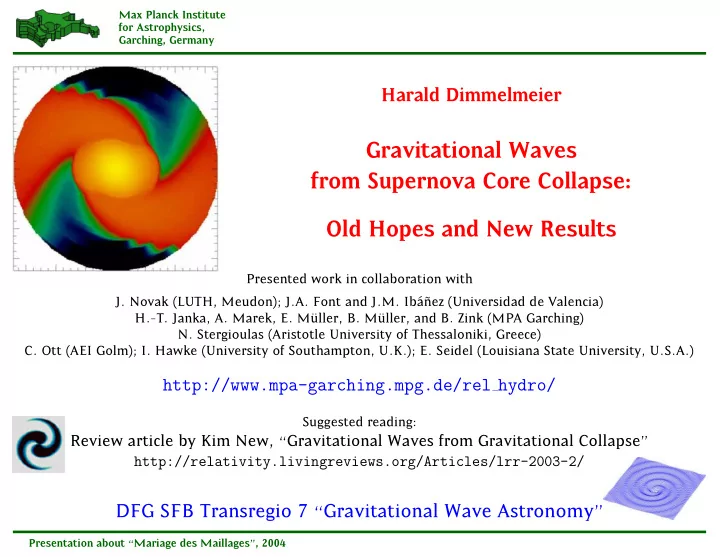

���������������������������������������������������������������������������������������������������������������������������������������������������������������������������������������������������������������������������������������������������������������������������������������������������������������������������������������������������������������������������������������������������� Max Planck Institute for Astrophysics, Garching, Germany Harald Dimmelmeier Gravitational Waves from Supernova Core Collapse: Old Hopes and New Results Presented work in collaboration with J. Novak (LUTH, Meudon); J.A. Font and J.M. Ib´ a˜ nez (Universidad de Valencia) H.-T. Janka, A. Marek, E. M¨ uller, B. M¨ uller, and B. Zink (MPA Garching) N. Stergioulas (Aristotle University of Thessaloniki, Greece) C. Ott (AEI Golm); I. Hawke (University of Southampton, U.K.); E. Seidel (Louisiana State University, U.S.A.) http://www.mpa-garching.mpg.de/rel hydro/ Suggested reading: Review article by Kim New, “Gravitational Waves from Gravitational Collapse” http://relativity.livingreviews.org/Articles/lrr-2003-2/ DFG SFB Transregio 7 “Gravitational Wave Astronomy” Presentation about “Mariage des Maillages”, 2004
���������������������������������������������������������������������������������������������������������������������������������������������������������������������������������������������������������������������������������������������������������������������������������������������������������������������������������������������������������������������������������������������������� Max Planck Institute Outline for Astrophysics, Garching, Germany Outline of the Talk • Astrophysical Context. • Gravitational Waves. -5.75 -4.77 -3.80 -2.83 -1.85 -0.88 • Models of Core Collapse. • Relativistic Equations. 80.0 • Numerical Methods. 60.0 • Tests and Applications. r [km] • Summary. 40.0 20.0 0.0 0.0 20.0 40.0 60.0 80.0 r [km] Presentation about “Mariage des Maillages”, 2004
���������������������������������������������������������������������������������������������������������������������������������������������������������������������������������������������������������������������������������������������������������������������������������������������������������������������������������������������������������������������������������������������������� Max Planck Institute Astrophysical Context for Astrophysics, Garching, Germany Astrophysical Sources of Gravitational Waves Want to sort out role of gravitational waves from core collapse. = ⇒ Compile list of possible astrophysical sources: • Coalescence and merger of supermassive black holes (evidence for galaxy mergers and black holes in galaxies). • Compact objects swallowed by supermassive black holes (dubbed bothrometry by Phinney). • Coalescence and merger of solar-mass-type binary black holes (estimates for event rates go up). • Coalescence and merger of binary neutron stars (possible delayed collapse to black hole). • White dwarf binaries (guaranteed source for LISA detector). • Cosmic gravitational wave background (remnant from Big Bang, no detectors so far). • Oscillations of neutron stars (from ringdown, secular or dynamical instabilities). • Collapse of supermassive stars to black hole (does this scenario exist?). • Collapse of Population III stars. • Finally: Collapse of core in massive star to neutron star (supernova core collapse, several emission mechanisms). Zoo of possible scenarios with various signal strengths and frequencies! Presentation about “Mariage des Maillages”, 2004
���������������������������������������������������������������������������������������������������������������������������������������������������������������������������������������������������������������������������������������������������������������������������������������������������������������������������������������������������������������������������������������������������� Max Planck Institute Astrophysical Context for Astrophysics, Garching, Germany The Standard Model for Supernova Core Collapse After decades of observation and computer simulations: Standard scenario for supernova core collapse has emerged (still uncertain and debated in details!). • Subsequent nuclear burning in massive star yields shell structure. • Iron core with M ∼ 1.4 M ⊙ and R ∼ 1000 km develops in center. • Equation of state: Relativistic degenerate fermion gas, γ = 4/3. • Instability due to photo-disintegration and electron capture. = ⇒ Evolution becomes strongly dynamic! • Collapse to nuclear matter densities in T ∼ 100 ms (collapse proceeds nearly adiabatically, neutrinos are trapped). • At nuclear matter density EoS stiffens, collapse is halted (core bounce, formation of prompt shock, shock stalls). • Proto-neutron star forms, deleptonization of matter. • Proto-neutron cools and shrinks, emits energy as neutrinos (gravitational binding energy was stored as internal energy). • Stalled shock revived by energy deposition from neutrinos. • Delayed shock propagates out and disrupts envelope of star. Presentation about “Mariage des Maillages”, 2004
Recommend
More recommend